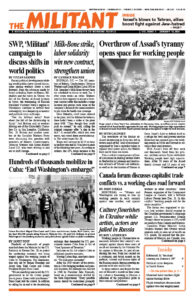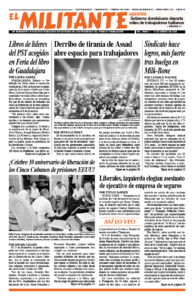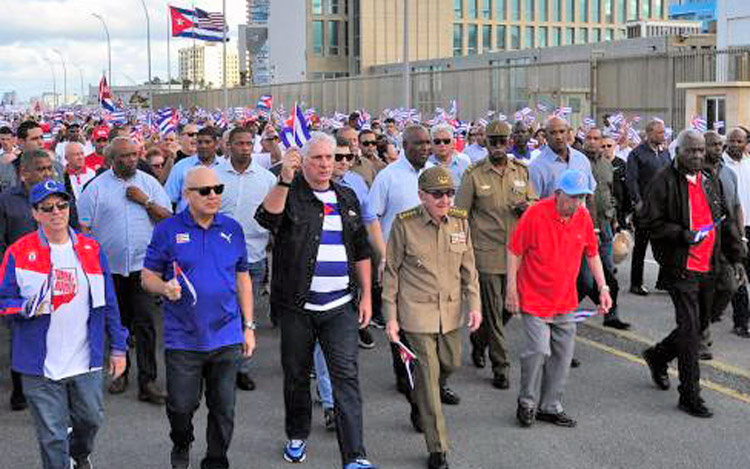Hundreds of thousands of people marched down the Malecón by the U.S. Embassy in Havana Dec. 20, to protest the unrelenting economic war being waged against the working people of Cuba by Washington. The demonstration was led by former President and Army Gen. Raúl Castro and Cuban President Miguel Díaz-Canel.
“We are marching now to tell the U.S. government to let the Cuban people live in peace. Down with interference!” Díaz-Canel told the crowd. In addition to calling for an end to the decadeslong embargo, they demanded the U.S. government remove Cuba from its list of “State Sponsors of Terrorism.”
Inclusion on this list subjects Cuba to additional punitive measures.
Waving Cuban flags, marchers chanted, “We will never surrender!”
After the 1959 victory of the revolution in Cuba bringing workers and peasants to power, the embargo was enacted in 1960 by President John Kennedy, based on a memorandum drafted by the State Department. “Every possible means should be undertaken promptly to weaken the economic life of Cuba,” it said, “denying money and supplies to Cuba, to decrease monetary and real wages, to bring about hunger, desperation and overthrow of government.”
Every U.S. president since, Democrat or Republican, has kept the embargo in place. Tightened by both Donald Trump and Joseph Biden, Cubans today face harsh shortages, including of foodstuffs, medicines, fuels, means of transportation, as well as the deterioration of many basic services.
On Oct. 30 Cuba’s Minister of Foreign Affairs, Bruno Rodríguez, told the United Nations General Assembly, “More than 80% of our population has only known Cuba under a blockade.” The body adopted a resolution calling for an end to the embargo 187 to 2, with one abstention. The U.S. and Israel were the two voting against.
The march showcased the determination of Cubans to defend their revolution.
Sixty-sixth anniversary
The march comes as the 66th anniversary of the victory of the first socialist revolution in the Americas, Jan. 1, 1959, is celebrated. The two great socialist revolutions in our epoch, the other being the 1917 Bolshevik Revolution in Russia led by V.I. Lenin, point the way forward for the working class worldwide.
The Cuban Revolution triumphed because of the central political role of Fidel Castro, leader of the July 26 Movement and the Rebel Army. He led workers and farmers to defeat the U.S.-backed dictatorship of Fulgencio Batista and take state power out of the hands of the capitalist class. This opened the door for the toiling majority to win land for the peasants, make ever-deeper inroads against capitalist property relations and transform itself in the process.
In a Jan. 1, 1979, speech celebrating the 20th anniversary of the revolution, Fidel Castro said, “Up until Jan. 1, imperialism was our indirect adversary; our direct adversary was Batista. After January, imperialism was our adversary directly. Before January, we fought to become the masters of our destiny; after January, we fought to defend this right and to carry out the socialist revolution.
“Before January, we were part of a national revolution; since that January, we have been part of the world revolution. Before January, a vanguard was the main protagonist in events; since that January, the main protagonist has been the people.”
Fidel Castro and the Cuban leadership understood, as Lenin and the Bolsheviks before them, that for the working class to take power into our own hands you need a Marxist leadership. And it means leading millions into revolutionary action.
In a speech known as the “Second Declaration of Havana,” Fidel Castro addressed a million workers and peasants in Havana’s Plaza of the Revolution Feb. 4, 1962.
“What is it that is hidden behind the Yankee’s hatred of the Cuban Revolution?” he asked. “What is it that rationally explains the conspiracy which unites, for the same aggressive purpose, the most powerful and richest imperialist power in the modern world and the oligarchies of an entire continent. … What unites them and stirs them up in fear?
“In their sleepless merchants’ and usurers’ minds there is the idea that revolutions can be bought, sold, rented, loaned, exported, and imported like some piece of merchandise,” he said. “They imagine that revolutions are born or die in the brains of individuals or are caused by divine laws, and, moreover, that the gods are on their side.”
But, he asked, “What does the Cuban Revolution teach? That revolution is possible, and the people can make it, and in the contemporary world there are no forces capable of halting the liberation movement of the peoples.”
The Cuban Revolution stands as an example for working people everywhere, including in the U.S.


